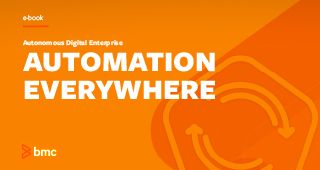Now, more than ever, it seems that automation has moved to the forefront of innovation. As a significant portion of the workforce—and people in general—have shifted to remote working and living, online and web/cloud-hosted functions and self-service tools have been on the rise. While initially envisioned as a gap-filler until people returned en masse to work, automation is now more likely to attain some permanence as a complementary function to human skills.
Automation Everywhere is one of the key tenets of the Autonomous Digital Enterprise, a framework that focuses on the future state of business as companies adopt emerging technologies and automation to not only survive, but thrive, in the face of persistent disruption. 2020 has had plenty of those.
The Automation Everywhere tenet embraces the idea of technology as a business function that works with humans, not in place of them, to enhance and improve their performance, efficiency, and innovation. A growing number of us are becoming more comfortable with automation in our daily lives. According to a recent Capgemini survey, 54 percent of consumers surveyed now use artificial intelligence (AI) every day versus just 21 percent in 2018.
Automation Everywhere goes hand in hand with the concept of hyperautomation, or automation that extends beyond mundane task replacement into more complex work through the emergence of AI, machine learning (ML), robotic process automation (RPA), and more technologies that can perform higher functions like predictive analytics.
As part of our Autonomous Digital Enterprise e-book series, we take a deeper dive into Automaton Everywhere and look at how automation informs seven business use cases:
- Cloud Automation: By devising strategies for integrating, automating, and orchestrating complex workflows across on-premises and multi-cloud infrastructures, businesses can ease the burden on management and accelerate application delivery and cloud adoption.
- File Transfer Automation: An external managed file transfer (MFT) platform that operates as a shared service for lines of business (LOBs) and partners can deliver coordinated, streamlined, and automated processes that are highly visible and recognized as mission-critical.
- Mainframe Automation: The automation and orchestration of all IT environments—on-premises and private and public clouds—and end-to-end workflows can ensure a consistent, reliable, risk-averse, and scalable mainframe.
- Intelligent Service Desk: Automation, AI, and ML can help improve agent efficiency and knowledge and the end-user experience versus historically disjointed, manual, inaccurate, and slow processes.
- Multi-Cloud Visibility: Automating the integration of private and public cloud environments with legacy infrastructure and software can create efficient processes, reclaim unused resources, optimize storage, and remediate security issues.
- Proactive Service Resolution: Proactive detection and automated response and remediation of events can speed restoration of service, improve efficiencies, and reduce costs.
- Enterprise Capacity Management: By automating data collection, analysis, and reporting to plan and manage IT capacity, companies can yield better performance and service quality while optimizing IT costs.
To learn more about Automation Everywhere, its use cases, and the BMC solutions that can help your business, visit the Automation Everywhere tenet page.
The Autonomous Digital Enterprise - Automation Everywhere
See an error or have a suggestion? Please let us know by emailing blogs@bmc.com.






